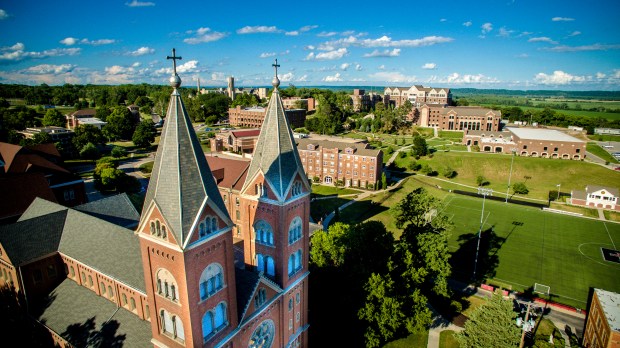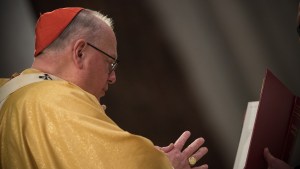The deaths of millions of unborn children through abortion in the United States would not have been possible without the “ready, willing, and active participation of physicians,” says a doctor who is spearheading a new medical school at a Catholic college in America’s heartland.
George Mychaskiw II, DO, is developing the school, which is planned to be located on the campus of Benedictine College in Atchison, Kansas (photo above). Benedictine College President Stephen D. Minnis and Catholic Healthcare International founder and President Jere D. Palazzolo signed a Collaborative Affiliation Agreement September 8 to begin the process of establishing the proposed Saint Padre Pio Institute for the Relief of Suffering, School of Osteopathic Medicine at Benedictine College. The agreement was signed during the annual meeting of the Catholic Medical Association in Denver, Colorado.
The school would be an independent institution, separately licensed, governed, financed and accredited. But for organizers, it’s important that it be on the grounds of what they say is a “faithful” Catholic institution of higher learning.
In an interview, Mychaskiw said that planners considered only colleges and universities that are listed in a college guide published by the Cardinal Newman Society, which has long criticized many Catholic colleges and universities for straying from the teachings of the Church. All of those listed in the guide looked promising, Mychaskiw said, but Benedictine “just worked out very well.” The college displayed enthusiasm for the project, he said, and President Minnis has a “strategic vision to reclaim the culture by incorporating more Catholicism into STEM education.”
According to a press release from Benedictine, the college’s new Strategic Plan, “Transforming Culture in America,” instructs the college to advance its Catholic mission “through science and health care by forming students comprehensively in bioethics and fostering external relationships.”
“So we fit very well into their strategic plan,” said Mychaskiw. “All the necessary bases aligned.”
Catholic bioethics
Mychaskiw, a Shreveport, Louisiana-based pediatric cardiac anesthesiologist has developed other medical schools in the past, but all have been secular projects.
“I’ve always felt there’s a need for a faithful Catholic medical school,” he said. “I thought there should be a medical school that really embraces the fundamental principles of the Catholic bioethics that stands for life, that stands for the disabled, that stands for men and women as God created them.”
A couple of years ago he learned about Catholic Healthcare International, an organization that wants to build an American version of the Casa Sollievo della Sofferenza, or Home for the Relief of Suffering, built by St. Pio of Pietrelcina in San Giovanni Rotondo, Italy. Plans include a hospital, a home for the brain injured, and a medical school. “So I wrote them and said, ‘Hey, I see you guys are going to do a medical school. I do medical schools. Maybe we can talk,’” Mychaskiw said.
He found that he was “very philosophically aligned” with Palazzolo in regards to the needs for a faithful Catholic medical school.
Nuts and bolts
The project is expected to cost $120 million, and once enough of that is raised – some $5 million – the school will begin to hire a dean and staff, and construction of a 100,000-sqare-foot building will begin.
“It will be a very contemporary, state of the art medical school, incorporating things like high fidelity simulation,” Mychaskiw said. “There will be several rooms that have these mannequins that talk and blink and breathe, and students interact with these as they’re learning basic patient care skills. There will be a clinic facility where people come from the community, and they’re like actors: they can be a patient who’s combative or a patient who doesn’t speak English, or a patient who is trying to explain symptoms. It helps the students learn their bedside manner and humanistic skills for medicine.”
The building will also contain a large laboratory where students learn the techniques of osteopathic manipulation.
“Osteopathic doctors believe touch can be healing,” WebMD explains. “All DOs are trained in osteopathic manipulative treatment, sometimes called manual manipulation or OMT. That’s a hands-on method to help diagnose and treat illnesses.”
Also planned for the new medical school is research in subjects such as ethical development of stem cells, ethical development of pharmaceuticals, diagnosis and management of patients in minimally conscious states, and resuscitation of brain injuries.
The school will lease land from Benedictine College and purchase student services from it, such as health and counseling services and meal plans. The medical school will provide a payment to Benedictine for the affiliation and for a co-branding of the St. Padre Pio Institute for the Relief of Suffering/School of Osteopathic Medicine at Benedictine College.
Students will spend two years in classrooms at the facility, and then two years working with “faithful Catholic and Christian physicians and faithful Catholic healthcare institutions,” Mychaskiw said. He said that Franciscan Alliance in Indiana and Illinois “will probably be one of our primary clinical training sites because they are a faithful Catholic healthcare system and they also have a preexisting relationship with Catholic Healthcare International.”
Being armored to fight a culture of death
Training with faithful Catholic physicians and in faithful Catholic healthcare facilities could help young doctors who now regularly struggle when they face moral dilemmas in their residencies. There have been reports of residents being given very little choice about whether to participate in abortions and other morally objectionable procedures.
But even the new medical school itself will be working to “armor these physicians with faithful Catholic truth so they’ll have the knowledge and courage to withstand those sorts of things,” Mychaskiw said.
“As part of the medical school accreditation process we are tasked to create residency training programs,” he said. “So we are planning on creating faithful Catholic residency training programs in fields like ob-gyn, pediatrics, psychiatry, family medicine. Additionally, while we’re still working out the curriculum, we know there will be a lot of Catholic bioethics and some theology in the curriculum, so students will better understand the Catholic perspective on these issues. We don’t quite know what it’s going to look like yet. We think students will have either an additional degree, a certification or credential in Catholic bioethics at the same time they graduate with their medical degree because of this.”
In addition, the medical school will offer a spiritual direction program to give students “a spiritual foundation, a basis, to be better armored to go out and be leaders in the medical community in standing for life and in supporting patients and other physicians that will stand for life,” Mychaskiw said. “It’s a very daunting thing to be a medical student and to be asked to participate in some sort of procedure or therapy that violates one’s conscience. It’s very hard for students to do that; they’re in a very vulnerable position, which is why our clinical training network will be in faithful Catholic institutions, and any physician that takes our students in as clerks – any physician preceptor – in that third and fourth year has to agree to maintain Catholic bioethical principles in their teaching and encounters with the student, and to indemnify the student and protect them from being forced to participate in procedures or therapies that would violate our principles.”
Subject to accreditation approvals, Mychaskiw said the school could open by Fall 2026. Ultimately, the school hopes to graduate about 150 new physicians each year. Mychaskiw sees that as a “multiplier effect” – seeding a new culture of life in a profession that, he and his colleagues believe, have contributed to a culture of death.
“Physicians have brought us to this culture of death, and it’s time for us to say no and take the culture back,” he said.
“It is vital to train future doctors at a place like Benedictine College that understands the essential role of faith and morality in the sciences,” said Minnis in a press release. “The campus culture of community, faith, and scholarship that we have worked so hard to create will be the perfect home for the proposed Padre Pio medical school at Benedictine College.”



